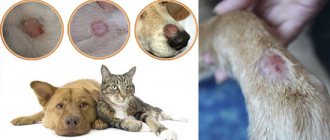Sterilization of dogs: pros and cons
Sterilizing dogs has both pros and cons. And each owner decides this issue independently, weighing the pros and cons of sterilizing the dog.
Pros of dog sterilization:
- There is no estrus, and as a result there is no bleeding, as well as no smell that attracts males.
- Absence of consequences of estrus - false pregnancy.
- The dog’s emotional state is stable, as there are no hormonal surges.
- Significant reduction in the risk of developing cancer (with early sterilization).
- Inability to reproduce.
As you can see, there are many advantages to sterilizing dogs. However, there are also risks.
Disadvantages of dog sterilization:
- Unusual individual reactions to the drug or manipulation are possible.
- Long rehabilitation period.
- Inability to reproduce.
- Risk of developing postoperative complications.
In the photo: sterilizing a dog allows you to avoid the birth of unplanned puppies
Physiological reasons
Natural causes of this phenomenon include pregnancy and lactation.
If such discharge is liquid and translucent, the breasts are swollen but soft, and the dog’s well-being does not deteriorate, then there are no pathologies of pregnancy. The problem is indicated by brown or reddish discharge with an unpleasant odor and cracked nipples.
After birth, colostrum should be released first, and after a few days, milk should be white, opaque and uniform in consistency. A variant of the norm is a slight tint of yellow in it.
If a nursing dog's glands become hardened and the milk becomes watery or slimy, she is developing mastitis.
The disease can also be suspected if the mother avoids feeding her offspring. This indicates pain and the onset of the disease.
Preparing a dog for sterilization
Another question that often worries owners: “How to prepare a dog for sterilization?”
First of all, I note that the indications for sterilizing a dog are:
- sexual desire,
- enlargement of reproductive organs,
- polycystic ovary syndrome,
- neoplasms,
- pyometritis,
- endometritis.
How to prepare a dog for sterilization? Keep in mind that sterilization is carried out under general anesthesia, so it is important to undergo preliminary diagnostics: ultrasound, biochemical and general blood tests, ECG.
An important part of preparing a dog for sterilization: a 12-hour fasting diet with active walking, without restrictions on drinking.
It is also necessary to wash and comb the dog.
Before the operation in the clinic, the doctor must examine the animal: measure temperature, pulse, respiration, blood pressure, conduct an external examination, and visually assess the dog’s condition. Only clinically healthy animals are allowed to undergo sterilization (if it is a planned operation).
Local signs
The dog's chest swells. Perhaps not all pairs of mammary glands are inflamed. The diseased gland noticeably increases in size. Stands out from the rest. May increase several times. When touched, the owner feels that the milk bag has increased density. His temperature is high. The animal may whine when touching a diseased organ. This means he is in pain. Swollen, painful breasts can also be found with lactostasis. The difference between diseases is the temperature of the milk carton. With mastitis it is very hot, and with lactostasis its temperature is slightly higher than normal.
The dog has a high fever. Mastitis in dogs is characterized by high body temperature. There may be an unquenchable thirst.
The color of the diseased milk carton changes. It becomes brick or deep red in color.
The dog licks a sore spot. Whines. Twitches. Does not allow puppies near this gland.
If milk is squeezed out of the nipple, its color may differ from normal. It may take on a yellowish or greenish tint. There may be discharge in the fluid. Depending on the type of illness, there may be particles of pus, blood, or thread-like fibers.
The milk has an unpleasant odor. Puppies cannot get enough or, conversely, do not breastfeed.
Important! Mastitis from one gland can spread to others.
Dog sterilization methods
- Ovariectomy
is a method of sterilizing a dog that involves removing the uterus and ovaries through an incision in the abdominal cavity. This is a fairly simple operation that is performed in a cavity manner. - Laparoscopy
is the least traumatic method of sterilizing a dog, which eliminates direct contact of the surgeon with the organs and tissues of the animal. The operation is performed by making small punctures (incisions) through which the laparoscope is inserted. This is one of the most modern methods of sterilization, which has many advantages, but is not used in all clinics. - Chemical sterilization of dogs
is a method of sterilizing dogs that involves the use of pharmaceutical drugs, which results in the temporary deprivation of the animal's ability to reproduce. This type of sterilization is very harmful to health - it is a 100% guarantee of the development of pyometritis, endometritis and oncology.
Many sources use the concept of endoscopic method of sterilization of dogs
, but this concept in itself is incorrect, since endoscopy implies penetration into the body through natural openings and is used for diagnostic purposes (probing).
Dog after sterilization: care
Proper care of your dog after sterilization is important. Competent actions by the owner will speed up the pet’s recovery after surgery. First of all, you should follow all the veterinarian’s instructions.
The first day is the most critical: in the first 24 hours after sterilization, the dog comes out of anesthesia, so you need to stay close to it and closely monitor its condition. It is important to pay attention to your breathing and heart rate.
In what cases is it necessary to urgently contact a veterinarian:
- Uneven, intermittent, heavy breathing with an open mouth.
- Gurgling, squelching, or wheezing sounds in the dog's chest.
- Body temperature is below or above normal. The norm is considered to be a decrease in temperature by no more than 0.5 degrees and an increase in temperature up to 1 degree in the first 2 days after anesthesia. A dog's normal body temperature is 37.5 - 39 degrees.
- Rare or, conversely, rapid heartbeat intermittently.
- Pale or bluish mucous membranes.
- Minor trembling that does not stop within 30 minutes or turns into convulsions.
An important part of caring for your dog after surgery is cleaning the sutures after sterilization.
Immediately after the sterilization surgery, your dog will have his stitches taken care of and put on a post-op blanket, so you won't have to worry about this for the first 24 hours. But after 24 hours you need to treat the seams.
It is important to follow the veterinarian’s recommendations, since the specific treatment of sutures after sterilizing a dog depends on the method of their application and the suture material. If the veterinarian says that there is no need to treat the suture after sterilization of the dog, but you see that the wound does not heal for a long time or becomes inflamed (discharge, rash, swelling or redness are visible), seek a second consultation.
Normally, the seam should be dry, without ulcers, crusts or scratches and other signs of an inflammatory process. Every day the condition of the seam should improve.
Caring for a dog after sterilization includes wearing a postoperative blanket, which protects the seam from mechanical damage and bacteria. Remember that one blanket may not be enough - it quickly gets wet and dirty. Therefore, it is advisable to change your dog’s post-operative blanket daily. There is no need to remove the blanket from the dog when processing postoperative sutures: just untie a few ribbons and move it to the side.
Caring for a dog after sterilization also involves limiting the animal's movement so that the stitches do not burst or stretch. Quiet walks without interacting with other dogs, running or jumping are preferable. If your dog has difficulty going up and down stairs, take him for a walk, but be careful: lifting or placing your pet on the ground incorrectly can damage the seam.
The dog should not be bathed for 3 weeks after surgery.
In the photo: in order to protect the stitches after sterilization of the dog from licking, sometimes it is necessary to put on the dog not only a blanket, but also a post-operative collar
Symptoms
Often, pet owners who see swollen hard mammary glands may make the diagnosis incorrectly. Inflammatory processes are confused with stagnation of milk, which is called lactostasis. To provide the animal with the necessary help, you need to understand some of the subtleties. After all, it is better to make the correct diagnosis yourself, even before going to the veterinary clinic. In this case, the owner of a sick pet has every chance to alleviate his condition. Mastitis in dogs has certain symptoms. Among the signs of the disease are those characteristic of all types of mastitis. The owner should immediately pay attention to them.
Sterilizing a dog at home
Sometimes owners ask if it is possible to sterilize their dog at home. There is such a possibility. Some veterinarians perform similar operations. However, keep in mind that sterilization is a surgical operation that is performed under general deep anesthesia, which means it is associated with risks. Therefore, it is much safer to sterilize a dog not at home, but in a clinic.
Hello. Female dog, 7 years old. Metis. Vaccinated and dewormed. Spayed at 4 years old. Whelped 2 times. Either the mammary glands or the lymph nodes closer to the loop are swollen. When pressed, he whines and reluctantly shows his belly. There is no discharge from the nipples. The glands on the abdomen and closer to the chest are not swollen. Temperature is normal. We won’t see the vet until Wednesday, can you tell me how likely the dog’s risk of cancer is?
On the Ask a Doctor service, you can consult a veterinarian on any problem that concerns you. Expert doctors provide consultations around the clock and free of charge. Ask your question and get an answer immediately!
Sterilization of a dog (female) is the removal of the gonads (ovaries or ovaries and uterus) from the female. After sterilization, the dog is not in heat and the animal cannot become pregnant.
The female reaches sexual maturity at the age of 6 to 12 months. A female dog comes into heat on average 2 times a year, the duration of the hunt is 8-15 days. Signs of estrus are swelling and redness of the loop, a small amount of bloody discharge. Also, the bitch devotes more time to genital hygiene, and males have increased interest in her.
During these periods, females fully correspond to their name “bitches”. Neutering animals makes them good family dogs. Why do the owners resist this? Here are some of the most typical statements we have heard:
— After sterilization, my dog will become fat and lazy. In reality, what makes a dog fat and lazy is overeating and lack of exercise. — Sterilization will affect the dog’s psyche. Sterilization is not brain surgery. Neutered dogs will still be protectors of their homes. “Shouldn’t my dog have at least one litter of puppies to be healthy?” No. This does not give anything to females, because childbirth does not improve women’s health! Our society habitually kills millions of animals every year simply because there are not enough homes for them. So don't make the problem worse! It is a fact that after sterilization your dog will live a happier, healthier and calmer life. Its main purpose is to be a good house dog, a family favorite, and sterilization will help it become just that. Therefore, every domestic dog must be sterilized. In addition, sterilized dogs, according to statistics, are much less likely to get hit by cars and run away from their owners.
The main indications for sterilization of bitches are:
- ovarian dysfunction, which manifests itself in the form of frequent or prolonged (more than 21 days) estrus, or its complete absence.
- false pregnancy is a physiological condition that occurs in unmated bitches, approximately 2 months after estrus. In dogs, the mammary glands swell, milk comes in, behavioral changes are observed (digging a nest for birth, caring for toys like puppies), and the temperature may rise due to mastitis.
- pathological changes of the uterus: glandular cystic hyperplasia of the endometrium, endometritis, pyometra, tumors of the uterus and ovaries.
- hormone-dependent tumors of the external genitalia and mammary glands.
- unwanted pregnancy and pregnancy pathologies.
If a bitch lives in an enclosure or in a yard outside the city, she has a very high probability of unscheduled mating. Males during estrus manage to dig into the yard and jump into the enclosure, so it is not always possible to isolate the bitch during the estrus period. Even on a walk in the presence of the owner, sometimes unwanted matings occur, since you simply cannot fight off a male dog. A whole flock of stray males can gather behind a female in heat, and this can be dangerous for the owner, especially if a child is walking with the dog. In addition, unplanned puppies may simply have nowhere to place them. Of course, there are drugs for medical termination of pregnancy in female dogs in the early stages (for example, mesalin), but such drugs can have serious side effects (pyometra in a dog, ovarian cysts), after which the dog will still have to be neutered.
Treatment of a dog with mastitis
If you notice that your dog's mammary gland is swollen, do not try to start treatment yourself. Both lactostasis and mastitis should only be dealt with by a veterinarian. You should not try to alleviate the animal’s condition at home without qualified veterinary care. And in any case, puppies are transferred to artificial feeding, otherwise they will begin to have problems with digestion (bacteria in milk are dangerous for a fragile puppy’s body).
It will be almost impossible to cure your pet without antibiotics, but therapy must be comprehensive. We need drugs that improve the outflow of exudate. And antibiotics are ideally selected based on titration results. It is necessary to conduct a bacteriological study of milk from the affected lobe, isolate the pathogen, and determine its sensitivity to antibiotics of various groups.
In the initial stages, good results can be achieved with physiotherapy (two to five sessions are required). But you shouldn't try to make them at home yourself. Massages and heating during purulent inflammation are prohibited, as they lead to pus entering the blood and surrounding tissues.
Also, at the initial stage, it is possible to achieve good results thanks to the novocaine blockade. It would be a good idea to learn how to properly express milk from the affected lobe in order to remove microorganisms and the ideal environment for their reproduction - milk - from the inflamed bag.
In addition, pumping will reduce pressure on damaged alveolar tissue and reduce pain. However, it is worth remembering that after expressing the milk comes again, so you will have to carry out this procedure repeatedly or immediately after emptying the gland, bandage it tightly.
If physiotherapy does not help, the veterinarian will prescribe antibiotic therapy and vitamin therapy. In more complex cases, surgical intervention is also necessary. The pustules are opened, washed and covered with powdered antibiotics.











